Tucks in sewing are a versatile and decorative technique that adds texture, depth, and structure to fabric projects. Whether you’re a seasoned seamstress or a novice in the world of sewing, tucks can be a valuable addition to your skill set.
Tucks involve folding and stitching fabric to create raised or gathered lines, enhancing the overall aesthetic and functionality of garments, home decor items, or accessories.
They come in various styles, such as pintucks, box pleats, and knife pleats, each offering a unique visual appeal.
Tucks not only serve as design elements but also have practical uses, like controlling excess fabric or providing ease of movement in clothing.
In this comprehensive guide, we’ll delve into the world of tucks in sewing, exploring their types, techniques, and creative applications.
What Is Tucks In Sewing?
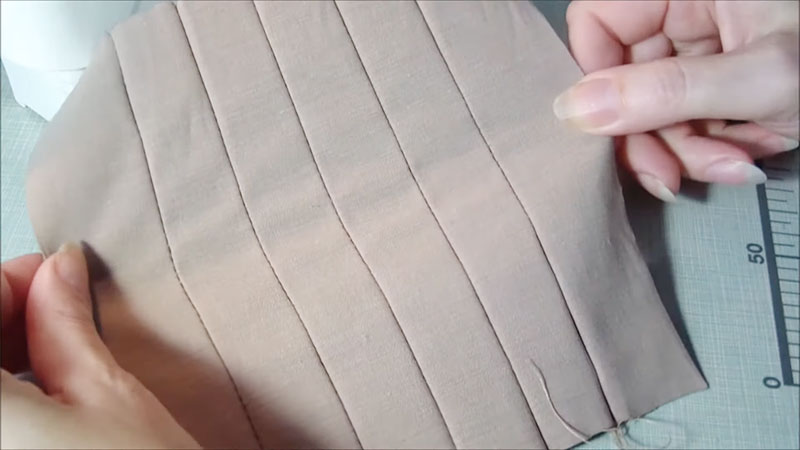
You aren’t sewing it in the right place. Your thread isn’t sticking to the fabric enough. You need a stronger seamstress tape. Your iron is too hot or not hot enough Wrong way around.
Tucks in sewing refer to small, neat, and controlled folds of fabric that are stitched down to create decorative or functional elements in a garment.
They can be used for both aesthetic and practical purposes. Tucks are typically created by folding the fabric along a designated line and then securing it with stitches, either by hand or with a sewing machine.
They can add texture, dimension, and visual interest to clothing, often used in bodices, cuffs, and collars. Additionally, tucks can be employed to adjust the fit of a garment or to manage excess fabric.
What Are the Types of Tucks?
There are several types of tucks in sewing, each with its own distinct style and purpose:
Pin Tucks
These are narrow, closely spaced tucks that add delicate texture and detail to a garment. Pin tucks are typically used for decorative purposes and are created by folding the fabric and stitching it close to the fold.
Box Pleat Tucks
These tucks are wider and create a boxy, folded effect. They are often used to add fullness to a garment, like in the back of a skirt or the front of a shirt.
Knife Pleat Tucks
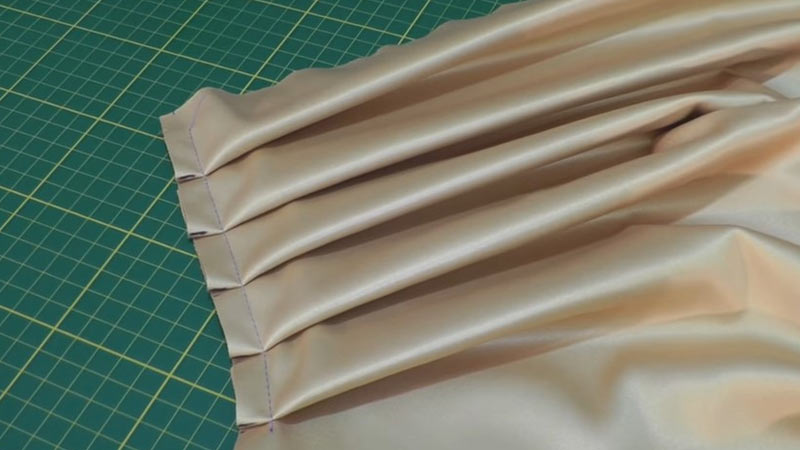
Knife pleats involve folding the fabric in one direction, typically with all folds facing the same direction. They are commonly used in school uniforms and various types of skirts.
Accordion Tucks
These tucks are similar to pin tucks but are wider and have more space between them. They create a more pronounced, decorative effect and are often used on cuffs or collars.
Gathered Tucks
Instead of folding the fabric, gathered tucks involve stitching down a gathered section of fabric. This adds volume and fullness to the garment, often used in sleeves or waistbands.
Release Tucks
Also known as inverted tucks, these involve folding the fabric in one direction and then releasing some of the stitching to create a relaxed, flowing effect. Release tucks are commonly seen in flowing skirts or dresses.
French Tucks
These are tucks that are hidden on the inside of a garment, typically used to secure lining or facing. They provide a clean finish to the inside of a garment.
Corded Tucks
In this type of tuck, a thin cord or piping is inserted into the fabric fold before stitching, creating a raised, decorative line along the tuck.
Shell Tucks
Shell tucks are wide, curved tucks that create a scalloped or shell-like edge. They are often used for decorative embellishments on children’s clothing or delicate fabrics.
These are just a few examples of the many tuck variations that can be used in sewing to add both style and functionality to garments. The choice of tuck depends on the desired aesthetic and practical purpose of the sewing project.
What Are Tucks In Sewing Used for?
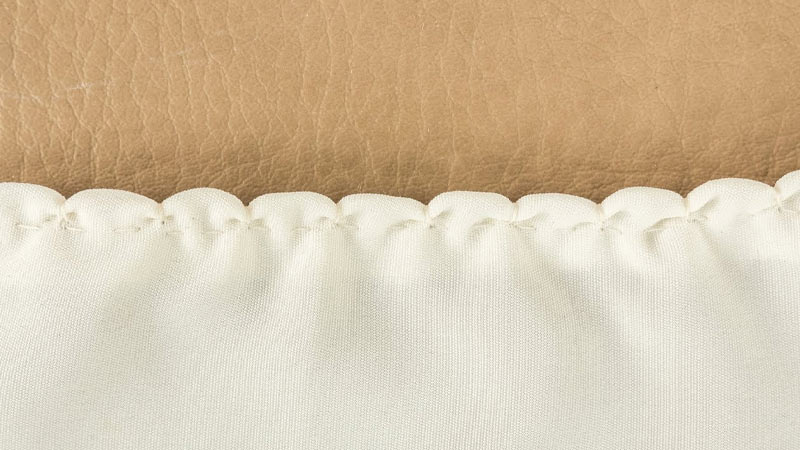
Tucks in sewing serve various purposes, both functional and decorative. Here are some common uses:
Decorative Detail
Tucks are often used to add visual interest and texture to a garment. Pin tucks, box pleat tucks, and accordion tucks, for example, can create intricate patterns and design elements.
Adjusting Fit
Tucks can be employed to adjust the fit of a garment. By folding and stitching excess fabric, they can make a garment smaller or provide a more tailored look.
Managing Excess Fabric
Tucks are useful for managing excess fabric, especially in areas where too much fabric may cause bulkiness. For instance, they can be used in the back of shirts to give a fitted appearance.
Creating Fullness
Some tucks, like box pleat tucks and gathered tucks, are used to add fullness to specific parts of a garment, such as skirts, sleeves, or bodices.
Securing Lining
French tucks are used to secure linings or facings on the inside of a garment while keeping the outer appearance clean and seamless.
Embellishment
Tucks can be used as embellishments, often combined with other decorative techniques like lace or embroidery to enhance the overall look of the garment.
Vintage or Historical Styles
Tucks are commonly found in vintage or historical clothing styles. They can be used to recreate the authenticity of a particular era’s fashion.
Textile Manipulation
Tucks can be used for textile manipulation to create three-dimensional effects or to shape fabric in unique ways, such as in smocking or shirring.
Hemming
Shell tucks, often seen in children’s clothing, can be used for hemming, providing a decorative edge to the garment’s bottom.
In essence, tucks in sewing are versatile techniques that offer both functional and aesthetic benefits, making them an essential tool for dressmakers and designers to achieve various design goals and styles.
What Is the Difference Between Tucks and Pleats?
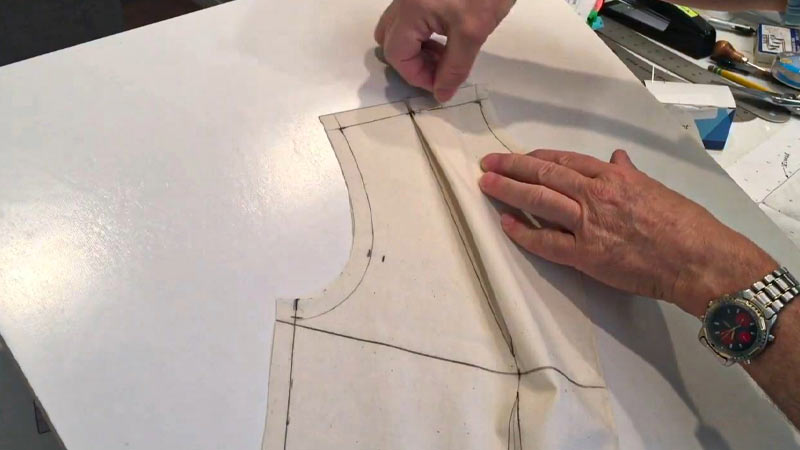
Tucks and pleats are both fabric manipulation techniques used in sewing, but they have distinct differences in terms of their appearance, purpose, and how they are created:
Appearance
- Tucks: Tucks involve folding a narrow section of fabric and then stitching it down to create a controlled, folded appearance.
They typically result in a raised, ridge-like effect on the fabric’s surface. Space tucks can be closely spaced for a more textured look or wider apart for a more delicate appearance. - Pleats: Pleats, on the other hand, involve folding a wider section of fabric, usually in a uniform manner, to create a flat, even fold. Pleats can be narrow or wide, and they lie flat against the fabric when not stretched out.
Purpose
- Tucks: Tucks are often used for both decorative and functional purposes. They can add texture, dimension, and visual interest to a garment. Tucks can also be used to adjust the fit of a garment or manage excess fabric in a controlled manner.
- Pleats: Pleats are primarily used for functional purposes. They are often employed to add fullness to a garment, like in skirts or pants. Pleats can also allow for ease of movement while maintaining a polished appearance.
Construction
- Tucks: Tucks are created by folding a section of fabric along a designated line and then stitching it down. They can be made by hand or with a sewing machine. Tucks can be very narrow, such as pin tucks, or wider, depending on the desired effect.
- Pleats: Pleats are formed by folding a wider section of fabric, typically with all folds facing the same direction. They can be machine-pressed or hand-pressed to ensure that they lay flat and evenly.
Appearance on the Fabric
- Tucks: Tucks result in a raised and folded texture on the fabric, creating a series of ridges or lines.
- Pleats: Pleats result in a smooth, flat appearance on the fabric’s surface when not stretched or pulled open.
The main difference between tucks and pleats lies in their appearance and purpose.
Tucks create raised, folded ridges and can serve both decorative and functional roles, while pleats create flat, evenly folded sections primarily for functional purposes like adding fullness to a garment.
Both techniques are valuable in sewing and can be used creatively to achieve various design effects.
How Do You Add Tucks to a Pattern?
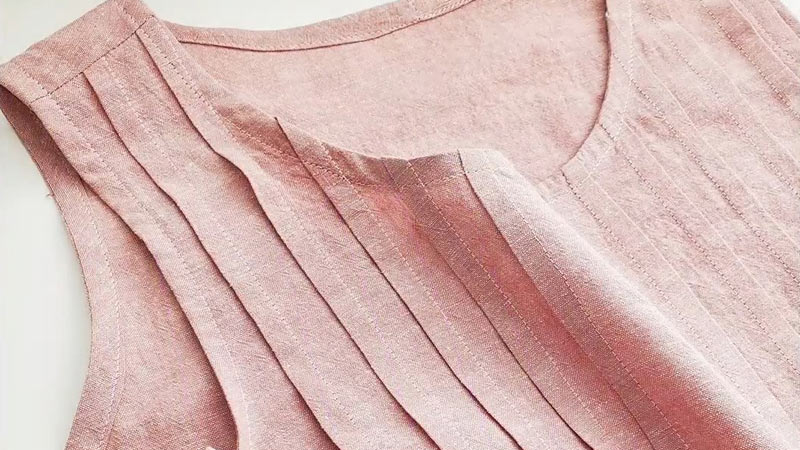
Adding tucks to a sewing pattern is a straightforward process. Here are four simple steps to follow:
Prepare Your Pattern and Fabric
Begin by selecting the sewing pattern you want to use. Ensure you have all the necessary pieces cut out and ready.
Choose your fabric and cut out the pattern pieces according to the instructions, making sure to include extra fabric for creating tucks.
Mark Tuck Placement
On your fabric pieces, mark the locations where you want to add tucks. You can use fabric chalk or removable fabric markers to make these marks.
Measure and mark the width and spacing of the tucks according to your desired design.
Create the Tucks
Fold the fabric along the marked lines for each tuck. Ensure that the folds are neat and align with your markings.
Pin the folds in place to secure them and prevent shifting during sewing.
Depending on your preference and the project, you can either hand-stitch the tucks or use a sewing machine to stitch them down. For machine stitching, select an appropriate stitch length for the tucks.
Finish Your Project
Once the tucks are securely stitched, continue with the sewing instructions for your pattern. This may involve joining pieces, adding closures, or completing any remaining construction steps.
Press the tucks with an iron to set them in place and give your project a polished look.
By following these steps, you can easily incorporate tucks into your sewing pattern to create decorative or functional elements in your garment.
Be sure to practice on scrap fabric first if you’re new to tucks to ensure you achieve the desired result.
Where Are Tucks Used in Garments?
The use of tucks in garments is to add decorative effect, fullness control, and shaping at various places on the garment such as shoulders, waistlines, yokes, etc.
They are also used in children’s clothing to hold their allowance for growth. Groups of tucks can be stitched together or they may have a partially sewn look which helps with shaping the garment.
They come in different shapes and sizes depending on the application required.
How Do You Put Tucks in a Skirt?
Adding tucks to a skirt is a great way to create texture and style. Here are four simple steps to put tucks in a skirt:
Prepare Your Skirt Pattern and Fabric
Start by selecting a skirt pattern that you’d like to use or draft your own pattern if you’re experienced.
Choose your fabric and cut out the skirt pattern pieces according to the instructions, including any additional width for the tucks.
Mark Tuck Placement
On the skirt fabric pieces, mark where you want to add tucks. You can use fabric chalk or removable fabric markers for this.
Determine the width and spacing of your tucks, keeping in mind that the tucks will reduce the overall width of the fabric.
Create the Tucks
Fold the fabric along the marked lines for each tuck, ensuring that the folds are neat and even. Pin the folds in place to secure them.
Depending on your preference and the project, you can either hand-sew the tucks or use a sewing machine with the appropriate stitch settings to stitch them down.
Be sure to backstitch at the beginning and end of each tuck to secure them.
Finish the Skirt
After securing the tucks, follow the remaining sewing instructions for your skirt pattern. This may involve joining skirt panels, adding a waistband, installing a zipper or elastic, and hemming.
Press the tucks with an iron to set them in place and give your skirt a finished look.
Lastly, try on the skirt to ensure it fits properly, and make any necessary adjustments before completing the finishing touches.
By following these four steps, you can easily add tucks to a skirt and create a unique and stylish garment with textured details. Be sure to practice on scrap fabric first if you’re new to working with tucks to perfect your technique.
Frequently Asked Questions
What is the difference between tucks and darts?
There are several key differences between tucks and darts. First, darts are sewn all the way through to the apex of each dart, whereas tucks have a fabric released at the point. This allows for more varied patterns as well as making it easier to create clusters of darts – something that is particularly important when creating Afghan rugs or other intricate designs.
What is a release tuck?
There is no one-size-fits-all answer to this question, as the release tuck will vary depending on the specific garment being created. However, if you are unsure of how to do a release tuck, consult with your fabric supplier or tailor.
Where are tucks made?
We are headquartered in Oak Brook, Illinois. Tucks are made here in the USA from high-quality materials to ensure you have an amazing product and great customer service.
What is a blind tuck?
To blind tuck, start by folding the fabric in half so that it is long and rectangular. Make a small hole near one end of the rectangle and press it closed with a seam allowance. Now make two more holes on either side of this first opening (it should look something like an X).
Bind these corners together with thread just enough to form a loop. Take the other piece of fabric and fold it in half so that both ends are facing out. Make another small opening at one end, then place your hand inside to help push the folded material into position- you will now have four loops formed. Sew each loop shut by sewing machine or by use of threaded binding tape.
When should you tuck in your shirt?
Tuck your shirt in when you get up and before you go to bed.
To Recap
Tucks in sewing are a timeless and versatile method that allows sewists to infuse creativity and dimension into their projects. Whether you’re looking to embellish a dress with delicate pintucks or add structure to drapery with box pleats, tucks offer endless possibilities.
With the right tools, techniques, and a touch of imagination, you can create stunning garments, home decor, and accessories that stand out.
Moreover, understanding how to manipulate fabric through tucks can be an essential skill for any sewing enthusiast. It not only enhances the visual appeal of your creations but also empowers you to solve practical design challenges.
So, dive into the world of tucks, experiment with different styles, and elevate your sewing projects to new heights.
Leave a Reply